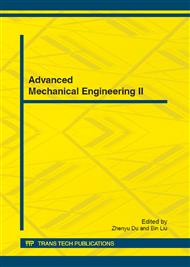[1]
Ministry of Public Security Traffic Management Bureau. The names of the Republic of China road accident statistics compiled [G]. Beijing: Public Security Traffic Authority, (2006).
Google Scholar
[2]
U.S. Department of Transportation, National Highway Traffic Safety Administration[R]. Traffic safety Facts1996~(2000).
Google Scholar
[3]
Xu Jun, Li Yibing. A Simulative Analysis on Bicyclist's Head Injury in Vehicle-Bicycle Collision Accident [J]. Automotive Engineering, 2008(8): 667~670.
Google Scholar
[4]
LIU Di, LI You de ZHAO Hang, ZHUXi-chan2. Simulative analysis of influence of vehicle forepart on pedestrian head injuries[J]: Journal of Jilin University (Engineering and Technology Edition): 2003. 33(4): 30~33.
Google Scholar
[5]
Ge Ruha, Wang Qiyan, Chen Xiaodong, Han Bing. Simulation Analysis and Test on Influencing Factors of Head Injuries in Car2pedestrianAccidents [J]. Automotive Engineering, 2007. (29)10: 838~841.
Google Scholar
[6]
Zhang Yichuan, Zhu Xichan, Miao Qiang, Wang Dazhi, Liu Junyong. Design Method of Engine Hood Based on Pedestrian Protection for Head Impact[J]. Automotive technology. 2009. 12: 24~27.
Google Scholar
[7]
Zhao Guifan, Yang Na. A Rigid Multi-body Model and the Simulation on Impact Response [J]. Transactions of the Chinese society for Agricultural. 2007. 1(38): 46~50.
Google Scholar
[8]
Zhang Yichuan, Zhu Xichan, Miao Qiang. An Analysis on the Pedestrian Protection Effects of Shock absorbing Glue in Engine Hood [J]. Automotive Engineering . 2010(vol32)4: 294~298.
Google Scholar
[9]
Qiao Weigao, Wang Xicheng. Simulation on Injury Severity of Pedestrian Impacted by Improved Vehicle Front Structure [J]. Journal of Wuhan University of Technology (Transportation Science & Engineering) . Vo l. 32No. 2. Apr. 2008: 218~221.
Google Scholar
[10]
Xiao feixue, Zhao shuyang. Pedestrian protection requirements of the automotive front system[J]. Shanghai Auto. 2008. 3: 18~21.
Google Scholar
[11]
GB/T244550-2009. The protection of motor vehicle for pedestrians in the event of a collision[S]. China Standard Publishing House (2009).
Google Scholar
[12]
Zhu weiYong. Optimal design in the industrial application [M]. Liaoning People Publishing House . (1993).
Google Scholar
[13]
Republic of China Machinery Industry standard - Process parameter optimization method orthogonal experiment JB / T 7510-1994 [S]. Machinery Research Institute.
Google Scholar
[14]
GE Ruhai. Wang Guangkuo, Wang Qiyan. Study on the Collision Protection Effect of Aluminum Engine Hoods [J]. China Safety Science Journal. 2007, 12(12): 38~41.
Google Scholar


